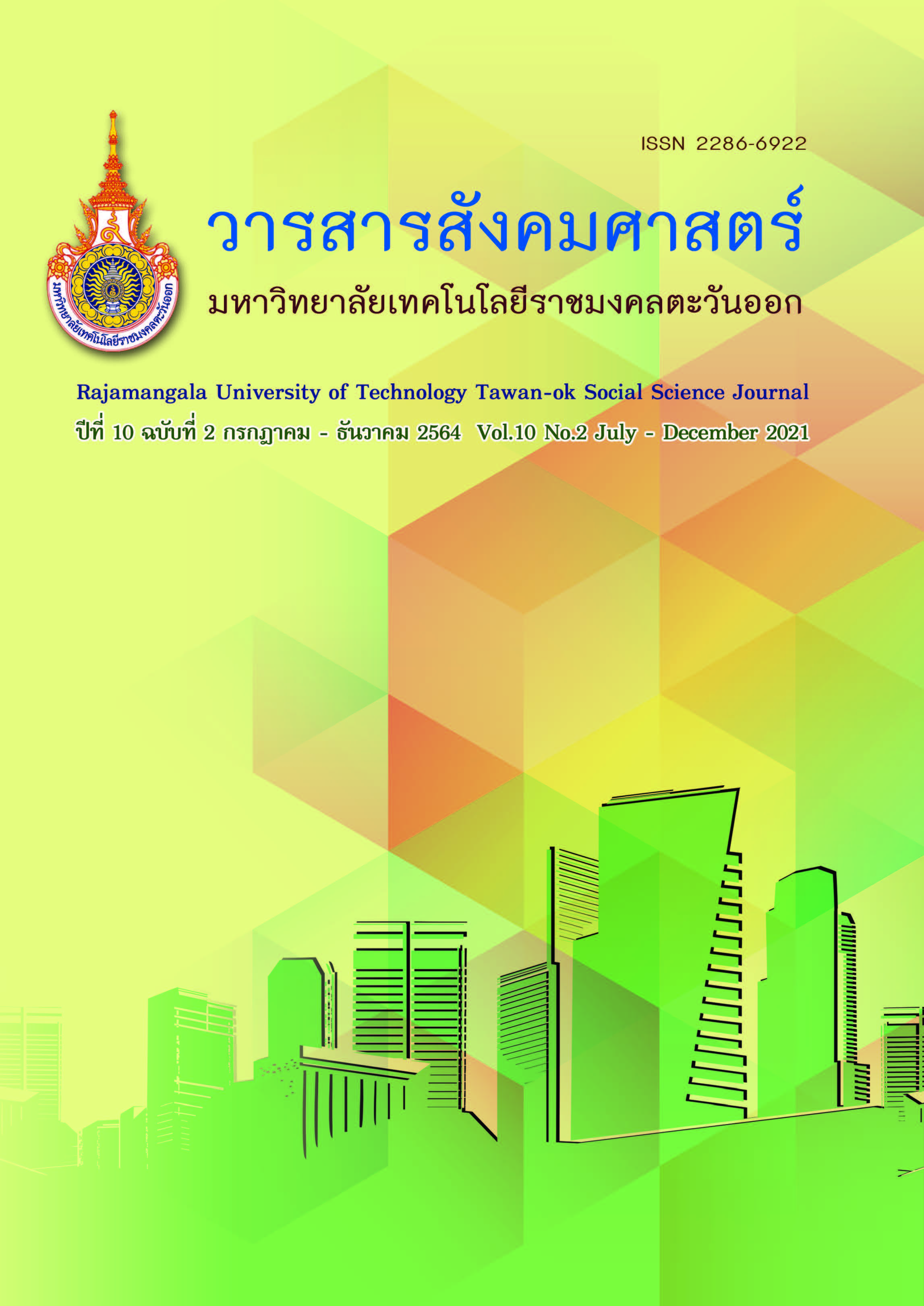Participatory Budgeting as A Social Innovation
Main Article Content
Abstract
This article suggests that participatory budgeting are a social innovation for three reasons: 1) It is synonymous with social innovation in terms of being a new approach to solving the problems of accumulated and complex society, especially the system. The bureaucratic power that is difficult to manage through budgeting with the public participation 2) There are areas that arise in accordance with the basic concept of understanding social innovation as they appear in the working area of the organization. And 3) there is an ideological source of social innovation that arises on the junction between the state and civil society
Article Details
How to Cite
Somsert, S. . (2021). Participatory Budgeting as A Social Innovation. Rajamangala University of Technology Tawan-ok Social Science Journal, 10(2), 93–100. retrieved from https://so05.tci-thaijo.org/index.php/SocialJournal2rmutto/article/view/249943
Section
Research Article
References
ชื่นฤทัย กาญจนะจิตรา. 2544. นวัตกรรมสังคม : การให้ความหมายและลักษณะกิจกรรมในประเทศไทย.คลังข้อมูลและความรู้ระบบสุขภาพ (Knowledge Bank). เว็บไซต์ https://kb.hsri.or.th/dspace/ สืบค้นเมื่อ 4 มกราคม 2564
ทิพวรรณ หล่อสุวรรณรัตน์. 2556. งบประมาณแบบมีส่วนร่วม: บทเรียนจากต่างประเทศและความท้าทายสำหรับประเทศไทย. วารสารการจัดการภาครัฐและภาคเอกชน. ปีที่ 20 ฉบับที่ 1 (มกราคม-มิถุนายน 2556)
สมนึก เอื้อจิระพงษ์พันธ์ และคณะ. 2553. “นวัตกรรม : ความหมาย ประเภท และความสำคัญต่อผู้ประกอบการ, วารสารบริหารธุรกิจ ปีที่ 33 ฉบับที่ 128 ตุลาคม – ธันวาคม 2553 : 49-65 http://www.jba.tbs.tu.ac.th/files/Jba128/Article/JBA128Somnuk.pdf (เข้าถึงเมื่อ 12 กุมภาพันธ์ 2560)
สฤณี อาชวานันทกุล. 2558. การจัดทำงบประมาณแบบมีส่วนร่วม (Participatory Budgeting). ThaiPublica. เว็บไซต์ https://thaipublica.org/2015/06/participatory-budgeting/ สืบค้นเมื่อ 4 มกราคม 2564
สุนทร คุณชัยมัง. 2563. นวัตกรรมสังคม พื้นที่ และการปฏิบัติการ. เอกสารประกอบการสอนรายวิชา CSI 703: ทฤษฎีนวัตกรรมสังคม หลักสูตรปรัชญาดุษฎีบัณฑิต วิทยาลัยนวัตกรรมสังคม มหาวิทยาลัยรังสิต, เอกสารเย็บเล่ม
Nicholls, A. and Murdock, A. (eds). 2012. Social Innovation: Blurring Boundaries to Reconfigure Markets. Basingstoke: Palgrave Macmillan, Retrieved December 25, 2020 from https://www.researchgate.net/publication/304881856_Introduction_Dimensions_of_Social_Innovation
Nicholls, A., Simon, J.,& Gabriel, M. 2015. Introduction: Dimensions of Social Innovation. Retrieved December 25, 2020, from https://www.researchgate.net/publication/304881856
Shah, Anwar. 2007. “Overview.” In Participatory Budgeting. Anwar Shah. (Ed.) The World Bank, Washington, DC., 1-18
Souza, C. 2001. Participatory budgeting in Brazilian cities: limits and possibilities in building democratic institutions. Environment & Urbanization, 13(1), 159-184
UN-Habitat. 2004. 72 Frequently Asked Questions about Participatory Budgeting. Urban Governance Toolkit Series, UN-Habitat, Quito.
Wampler, Brian. 2000. A Guide to Participatory Budgeting. Paper presented at the third conference of the International Budget Project, Mumbai, November 4-9, Retrieved December 25, 2020 from http://www.internationalbudget.org/cdrom/papers/systems/ParticipatoryBudgets/Wampler.pdf.
ทิพวรรณ หล่อสุวรรณรัตน์. 2556. งบประมาณแบบมีส่วนร่วม: บทเรียนจากต่างประเทศและความท้าทายสำหรับประเทศไทย. วารสารการจัดการภาครัฐและภาคเอกชน. ปีที่ 20 ฉบับที่ 1 (มกราคม-มิถุนายน 2556)
สมนึก เอื้อจิระพงษ์พันธ์ และคณะ. 2553. “นวัตกรรม : ความหมาย ประเภท และความสำคัญต่อผู้ประกอบการ, วารสารบริหารธุรกิจ ปีที่ 33 ฉบับที่ 128 ตุลาคม – ธันวาคม 2553 : 49-65 http://www.jba.tbs.tu.ac.th/files/Jba128/Article/JBA128Somnuk.pdf (เข้าถึงเมื่อ 12 กุมภาพันธ์ 2560)
สฤณี อาชวานันทกุล. 2558. การจัดทำงบประมาณแบบมีส่วนร่วม (Participatory Budgeting). ThaiPublica. เว็บไซต์ https://thaipublica.org/2015/06/participatory-budgeting/ สืบค้นเมื่อ 4 มกราคม 2564
สุนทร คุณชัยมัง. 2563. นวัตกรรมสังคม พื้นที่ และการปฏิบัติการ. เอกสารประกอบการสอนรายวิชา CSI 703: ทฤษฎีนวัตกรรมสังคม หลักสูตรปรัชญาดุษฎีบัณฑิต วิทยาลัยนวัตกรรมสังคม มหาวิทยาลัยรังสิต, เอกสารเย็บเล่ม
Nicholls, A. and Murdock, A. (eds). 2012. Social Innovation: Blurring Boundaries to Reconfigure Markets. Basingstoke: Palgrave Macmillan, Retrieved December 25, 2020 from https://www.researchgate.net/publication/304881856_Introduction_Dimensions_of_Social_Innovation
Nicholls, A., Simon, J.,& Gabriel, M. 2015. Introduction: Dimensions of Social Innovation. Retrieved December 25, 2020, from https://www.researchgate.net/publication/304881856
Shah, Anwar. 2007. “Overview.” In Participatory Budgeting. Anwar Shah. (Ed.) The World Bank, Washington, DC., 1-18
Souza, C. 2001. Participatory budgeting in Brazilian cities: limits and possibilities in building democratic institutions. Environment & Urbanization, 13(1), 159-184
UN-Habitat. 2004. 72 Frequently Asked Questions about Participatory Budgeting. Urban Governance Toolkit Series, UN-Habitat, Quito.
Wampler, Brian. 2000. A Guide to Participatory Budgeting. Paper presented at the third conference of the International Budget Project, Mumbai, November 4-9, Retrieved December 25, 2020 from http://www.internationalbudget.org/cdrom/papers/systems/ParticipatoryBudgets/Wampler.pdf.


